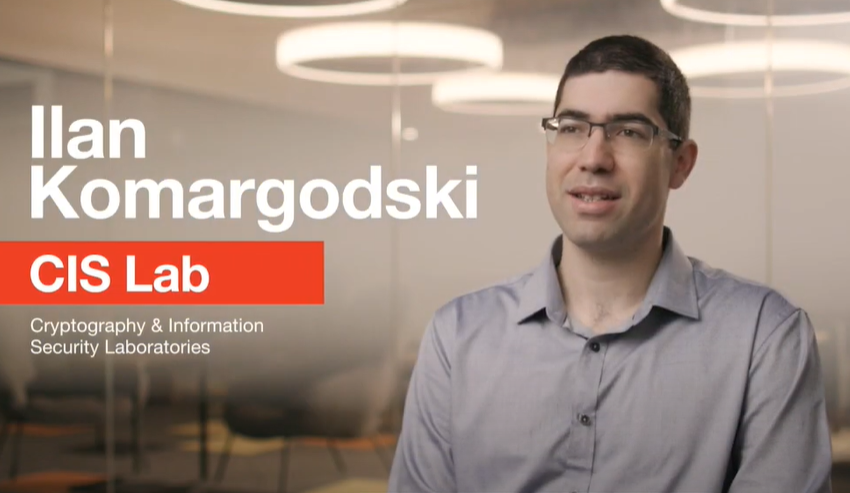Ilan Komargodski joined the NTT Research Cryptography & Information Security (CIS) Lab in 2019. He is also a faculty member in the School of Computer Science and Engineering at the Hebrew University of Jerusalem. Before that, he spent two years at Cornell Tech, where he was hosted by Professors Rafael Pass and Elaine Shi. He completed his Ph.D. at the Weizmann Institute of Science in 2017. His research focuses on foundational aspects of computer science, with an emphasis on cryptography and its interplay with other fields in computer science. For more on what he is working on, who influenced him academically, and why he found the CIS Lab a good fit, please read the following Q&A:
At Upgrade 2020 (Sept 30, 6:50-7:10 pm) you spoke about your work (with Ephraim, Freitag and Pass) on Succinct, Parallelizable Arguments of Knowledge, or SPARKs. You said that one of your motivations was the scenario of a weak device delegating a computation to a cloud service, but also needing a proof of correctness. That seems relevant today. Is that why you chose to speak on that topic?
Indeed, this paper addresses a fundamental and critical problem that exists in modern implementations of such primitives.
What other protocols for secure cloud computation are you working on? Would Multi-Party Computation (MPC) and homomorphic encryption (which you nicely described in this video as almost magical way of interacting with a locked box of data) fall into that category?
There are a few, but more than I can address in a short interview. I’ll try to give one example that touches upon many of the terms you mentioned. For Eurocrypt 2021, I co-authored a paper titled “Multi-Party Reusable Non-Interactive Secure Computation from LWE.” Motivated by the goal of designing versatile and flexible secure computation protocols that at the same time require as little interaction as possible, in this paper, we presented new multiparty reusable Non-Interactive Secure Computation (mrNISC) protocols. This notion is essentially two-round Multi-Party Computation (MPC) protocols where the first round of messages serves as a reusable commitment to the private inputs of participating parties. Using these commitments, any subset of parties can later compute any function of their choice on their respective inputs by just sending a single message to a stateless evaluator, conveying the result of the computation but nothing else. Importantly, the input commitments can be computed without knowing anything about other participating parties (neither their identities nor their number) and they are reusable across any number of desired computations. Our construction relies upon and utilizes techniques that originate from the homomorphic encryption literature.
Another theme or keyword associated with your work is “bounds.” For your non-expert audience, what does that mean in terms of your research and work on computational models?
A bound is just a quantity. It’s not a technical word. For instance, if an algorithm requires X steps of computation on some inputs but say 2X on all others, we say that 2X is an upper bound on the running time of the algorithm. Bound can be associated with any resource (time, space, etc.).
That term is also associated with Professor Ran Raz, with whom you studied at the Weizmann Institute. How did he influence your thinking, and what did you take away from him? Could we ask that question regarding Professor Moni Naor, your Ph.D. advisor?
Prof. Raz was my M.Sc. advisor and he taught me the very first things about how to do research and how to tackle problems. He is an amazing researcher and also a role model for many other researchers. I think Ran taught me that sometimes it might take a long time to solve a problem that you care about, and one shouldn’t give up quickly. Moni was my Ph.D. advisor, and I had the pleasure to spend a lot of time with him. Naturally, he had a very significant and meaningful influence on the process of shaping me as a researcher. Moni taught me to always keep an open eye for interesting scientifical advances. Namely, never to be too focused on my own research, but to be aware of what is happening in adjacent fields of science. Moni taught me that knowledge is power and that sometimes the simplest observations are very important. Until this day I look up to Moni and the way he does research. He is a great role model.
Why did you see NTT Research as an organization compatible with your own research agenda and what are you hoping to accomplish through your work with the CIS Lab?
NTT Research offers a fantastic work environment and resources that no other place can offer; not even remotely close. The academic freedom is amazing. The colleagues that are already part of the lab and the newest recruits make this one of the (if not “the”) best places to do research and fulfill our personal goals. I see a very bright future for the company! Personally, I hope to do good work and continue my path in research. Mostly, I hope to keep exploring and inventing new technologies that could help design a better and more secure future for mankind.


